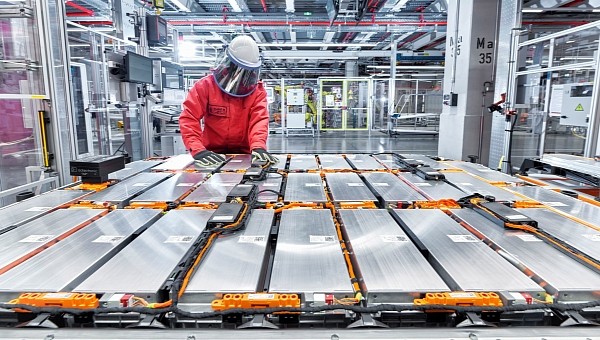The future of electric vehicles largely depends on how fast EV battery development advances. For now, Li-Ion batteries rule the world, but new research into Li-air batteries might make them obsolete. Scientists at the Illinois Institute of Technology think they have found the perfect formula to get four times the power density of today’s best Li-Ion batteries.
There are several ways you can make an electric vehicle go further on a battery charge. The simplest one is to increase the battery capacity, hoping customers would be willing to pay the added price. Although many carmakers have chosen this path, it is not always the wisest. Besides being more expensive, electric cars with big batteries are also heavy, which impacts their efficiency. Other carmakers, like Lucid and Tesla, have become quite good at minimizing losses, boosting efficiency to go further with a smaller battery pack.
The hardest thing to do is to increase battery capacity while keeping the battery’s volume and weight unchanged. This requires rethinking the battery cells and often alterations to the chemical formula of the electrodes, the electrolyte, or both. New chemistries hold impressive characteristics in some areas but are still lacking in other departments. Solid-state batteries, for instance, have higher energy densities, but they have a very short life span.
Another type of battery that promises to offer an increased energy density is the Lithium-air battery. The theoretical energy density is several times that of Li-ion batteries and even Lithium-Sulfur cells. The concept is not new, but until now, no one could solve the many problems this type of cell has. For once, they are notoriously unstable because the lithium metal reacts with both the moisture in the air and the water in the electrolyte. Their efficiency is also very low because the charge and discharge voltage difference is very large, causing energy losses.
Scientists at the Illinois Institute of Technology think they have found the winning formula for commercially viable Li-air batteries. The team led by assistant professor of chemical engineering Mohammad Asadi pioneered a new electrolyte, combining polymer and ceramic, the most common solid electrolytes. They both have downsides when used separately. But when combined, they offer the best solution, with the high ionic conductivity of the ceramic and the increased stability and high interfacial connection of the polymer.
The new ceramic-polyethylene oxide–based composite solid electrolyte allows the lithium-dioxide formation and decomposition to occur at high rates at room temperature, a first in a lithium-air battery. The battery design has the potential to store 1 kWh per kilogram or higher, an energy density four times higher than the current most advanced Li-Ion batteries in the industry, produced by Tesla. Even better, the team thinks it can be further increased through optimization.
“We found that solid-state electrolyte contributes around 75 percent of the total energy density. That tells us there is a lot of room for improvement because we believe we can minimize that thickness without compromising performance, and that would allow us to achieve a very, very high energy density,” says Asadi.
The new electrolyte shows high ionic conductivity and stability and high cycle stability. According to the paper published in Nature, the new battery is rechargeable for 1,000 cycles and can operate at high charge and discharge rates. This is essential in a high-performance electric vehicle.
The hardest thing to do is to increase battery capacity while keeping the battery’s volume and weight unchanged. This requires rethinking the battery cells and often alterations to the chemical formula of the electrodes, the electrolyte, or both. New chemistries hold impressive characteristics in some areas but are still lacking in other departments. Solid-state batteries, for instance, have higher energy densities, but they have a very short life span.
Another type of battery that promises to offer an increased energy density is the Lithium-air battery. The theoretical energy density is several times that of Li-ion batteries and even Lithium-Sulfur cells. The concept is not new, but until now, no one could solve the many problems this type of cell has. For once, they are notoriously unstable because the lithium metal reacts with both the moisture in the air and the water in the electrolyte. Their efficiency is also very low because the charge and discharge voltage difference is very large, causing energy losses.
Scientists at the Illinois Institute of Technology think they have found the winning formula for commercially viable Li-air batteries. The team led by assistant professor of chemical engineering Mohammad Asadi pioneered a new electrolyte, combining polymer and ceramic, the most common solid electrolytes. They both have downsides when used separately. But when combined, they offer the best solution, with the high ionic conductivity of the ceramic and the increased stability and high interfacial connection of the polymer.
The new ceramic-polyethylene oxide–based composite solid electrolyte allows the lithium-dioxide formation and decomposition to occur at high rates at room temperature, a first in a lithium-air battery. The battery design has the potential to store 1 kWh per kilogram or higher, an energy density four times higher than the current most advanced Li-Ion batteries in the industry, produced by Tesla. Even better, the team thinks it can be further increased through optimization.
“We found that solid-state electrolyte contributes around 75 percent of the total energy density. That tells us there is a lot of room for improvement because we believe we can minimize that thickness without compromising performance, and that would allow us to achieve a very, very high energy density,” says Asadi.
The new electrolyte shows high ionic conductivity and stability and high cycle stability. According to the paper published in Nature, the new battery is rechargeable for 1,000 cycles and can operate at high charge and discharge rates. This is essential in a high-performance electric vehicle.






